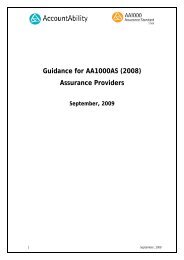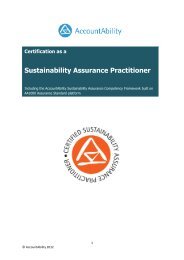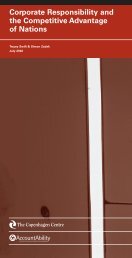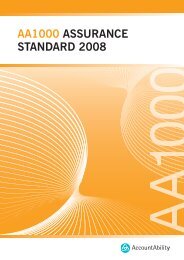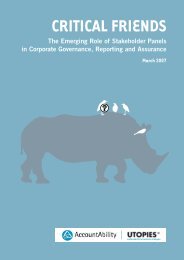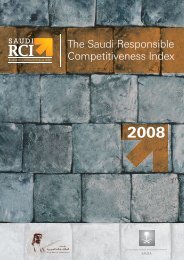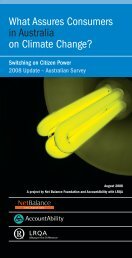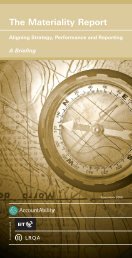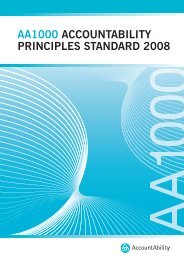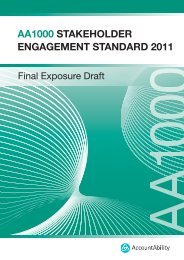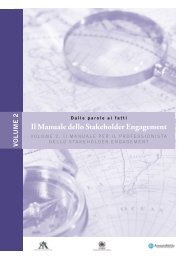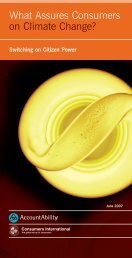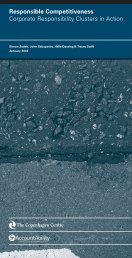The Stakeholder Engagement Manual Volume 2 - AccountAbility
The Stakeholder Engagement Manual Volume 2 - AccountAbility
The Stakeholder Engagement Manual Volume 2 - AccountAbility
You also want an ePaper? Increase the reach of your titles
YUMPU automatically turns print PDFs into web optimized ePapers that Google loves.
Take action and review the engagement<br />
P17: REPORTING BACK AND GIVING ASSURANCE TO YOUR STAKEHOLDERS<br />
Thinking about Assurance<br />
Consideration<br />
Assurance Appetite<br />
Who needs assuring?<br />
What is the pupose<br />
of the assurance<br />
process?<br />
Assurance Methodology<br />
What standards and<br />
principles govern the<br />
assurance process?<br />
Assurance Scope<br />
What is the objective?<br />
What is the nature of<br />
the subject matter?<br />
What are the<br />
‘boundaries’ of the<br />
assurance process?<br />
Options<br />
Indoor stakeholders: management and board concerned with risk and value creation<br />
require assurance that information is accurate and complete, and that systems are working<br />
Back-door stakeholders: investors and regulators interested in assurance that looks<br />
governance, risk and legal compliance<br />
Front-door stakeholders: media and NGOs who often remain cynical about corporate<br />
CSR or SD efforts, or customers that may well appreciate product certifi cation.<br />
Meeting legal compliance requirements: e.g. for fi nancial and environmental reporting.<br />
Convincing: building trust and credibility or gaining a specifi c certifi cation.<br />
Decision-making: ensuring the credibility of information that stakeholders use for<br />
decision-making<br />
Learning: monitoring and continuous improvement of management systems.<br />
ISAE3000: offers practical guidance for non-fi nancial assurance engagement for<br />
professional service provides from fi nancial audit fi rms.<br />
AA1000 Assurance Standard: provides an overarching commitment to promote<br />
accountability for sustainable development through stakeholder inclusivity, which is<br />
supported by the three key principles of materiality, completeness and responsiveness;<br />
AA1000AS is compatible with other assurance standards such as ISAE3000 but also<br />
sustainability reporting frameworks like the GRI Sustainability Reporting Guidelines.<br />
National Standards: <strong>The</strong>re are a vast range of further national assurance standards,<br />
which should also be taken into account.<br />
Testing data: checking that the information presented is complete and accurate.<br />
Checking systems: testing if the management and information systems are robust.<br />
Assessing materiality and risk: understanding the core business implications for the<br />
organisation.<br />
Assessing compliance and responsiveness: assessing how the organisation is doing in<br />
response to standards, commitments and stakeholder expectations.<br />
Commentary: discourse on how well the organisation is doing and how it could improve.<br />
Broad: aims to cover overall sustainability performance<br />
Specifi c: specifi ed aspects of social, environmental and economic performance,<br />
qualitative and/or quantitative information and/or systems. Subject matter can<br />
be historical or forward looking<br />
Site-specifi c: e.g. supplier audits.<br />
Product-specifi c: e.g. assurance for labelling.<br />
Company or group level: e.g. sustainability reports.



